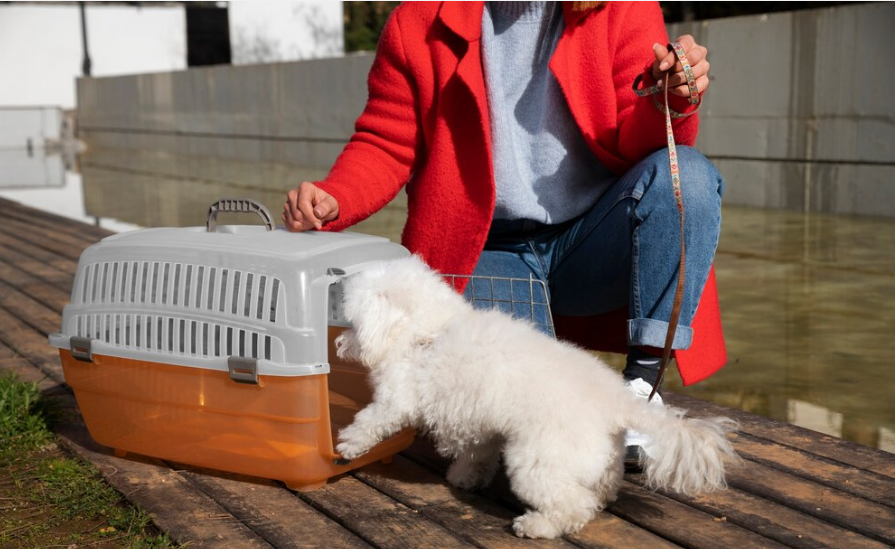
Crate training is a highly effective and humane method to help dogs feel secure and behave appropriately indoors. It’s especially useful for housebreaking puppies, managing separation anxiety, and creating a safe space for your pet. This comprehensive guide will walk you through the stress-free crate training process, highlight common mistakes, and provide tips for choosing the right crate size.
What Is Crate Training and Why Is It Important?
Crate training involves teaching your dog to see their crate as a safe and comfortable personal space. When done correctly, it should never feel like a punishment. Benefits of crate training include:
-
- Aiding in potty training
-
- Preventing destructive behavior when unsupervised
-
- Easing travel and vet visits
-
- Reducing anxiety by offering a secure space
-
- Facilitating recovery post-surgery or illness
When to Start Crate Training
Crate training can begin as early as 8 weeks old. The sooner a dog is introduced to a crate, the easier it usually is to adapt. However, even adult dogs can be crate trained with patience and consistency.
Choosing the Right Crate Size and Type
The crate must be large enough for your dog to stand, turn around, and lie down comfortably, but not so large that they can soil one end and sleep on the other.
Crate Types:
-
- Wire Crates: Good ventilation, collapsible, ideal for training.
-
- Plastic Crates: Often used for travel, cozier feel.
-
- Soft-sided Crates: Lightweight, best for calm dogs.
-
- Heavy-duty Crates: For escape artists or anxious dogs.
How to Measure Your Dog for a Crate:
-
- Measure from nose to tail base, add 2–4 inches.
-
- Measure height from floor to top of the head, add 2–4 inches.
Step-by-Step Guide to Crate Training Your Dog
Step 1: Introduce the Crate
-
- Place the crate in a busy area of the home.
-
- Keep the door open and let your dog explore at their own pace.
-
- Use treats, toys, and praise to encourage interest.
Step 2: Make the Crate Inviting
-
- Add soft bedding and a few chew toys.
-
- Feed meals near or inside the crate to build positive associations.
Step 3: Begin Short Sessions
-
- Ask your dog to enter the crate using a cue like “crate” or “bed.”
-
- Close the door briefly while you’re nearby, gradually increasing duration.
-
- Always reward calm behavior inside the crate.
Step 4: Increase Crating Time
-
- Gradually crate your dog while you leave the room.
-
- Extend the time up to 30 minutes before leaving the house.
-
- Return calmly and reward them for good behavior.
Step 5: Crate When Leaving and at Night
-
- Always crate with a calm, confident demeanor.
-
- Include a favorite toy or chew for entertainment.
-
- Maintain a regular routine to build predictability.
Common Mistakes to Avoid
-
- Using the Crate as Punishment – This creates fear and resistance.
-
- Leaving the Dog Crated Too Long – Puppies under six months shouldn’t be crated for more than 3–4 hours.
-
- Skipping the Gradual Process – Rushing the steps can cause stress.
-
- Ignoring Signs of Anxiety – Whining, barking, or destructive behavior may indicate fear.
-
- Not Making the Crate Comfortable – Uninviting crates reduce success.
How Long Should Dogs Stay in a Crate?
-
- Puppies under 6 months: 1 hour per month of age (up to 4 hours max)
-
- Adult dogs: No more than 6–8 hours
-
- Senior dogs: Depends on health and mobility
Dealing with Whining and Barking
If your dog barks or whines:
-
- Wait until they’re quiet before opening the door.
-
- Don’t scold; instead, reinforce calm behavior.
-
- Ensure they’ve had potty breaks, exercise, and attention.
Alternatives to Crate Training
-
- Playpens: Great for puppies who need more space.
-
- Baby Gates: Use them to block off a dog-safe room.
-
- Training Pads: Useful in combination with crate training for young pups.
Traveling with a Crate
-
- Familiarize your dog with the travel crate before a trip.
-
- Bring familiar bedding and toys.
-
- Use a seatbelt clip or place the crate securely in the car.
Crate Training for Rescue or Anxious Dogs
For dogs with past trauma:
-
- Be extra patient and gentle.
-
- Use high-value treats and quiet environments.
-
- Consider pheromone sprays or consult a dog behaviorist.
Crate Training and Housebreaking
Crates are powerful tools in house training:
-
- Dogs usually won’t soil their sleeping space.
-
- Take them out after naps, meals, and play sessions.
-
- Use consistent potty cues and rewards.
FAQs About Crate Training
Q: Is crate training cruel?
A: Not when done properly. It offers security and structure.
Q: How do I stop my dog from chewing the crate?
A: Provide chew-proof toys and address boredom with exercise and stimulation.
Q: Can I crate my dog while at work?
A: Yes, but it’s ideal to have a midday break or dog walker.
Q: Should the crate be in the bedroom?
A: For puppies or anxious dogs, yes. Eventually, you can transition it elsewhere.
Final Thoughts
Crate training your dog doesn’t have to be stressful. With the right approach, crate training becomes a powerful way to improve your dog’s well-being, build trust, and maintain a peaceful home. Take your time, stay consistent, and always prioritize your dog’s comfort and emotional health.